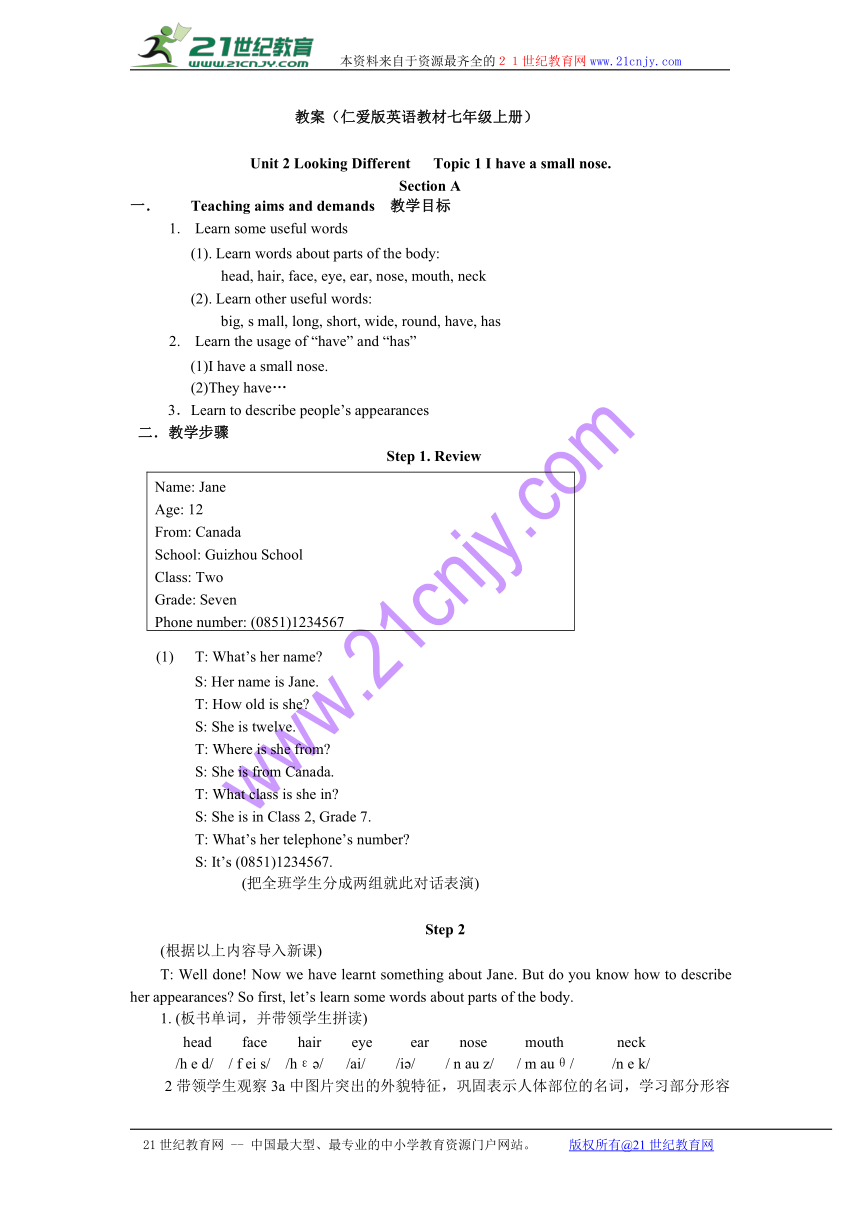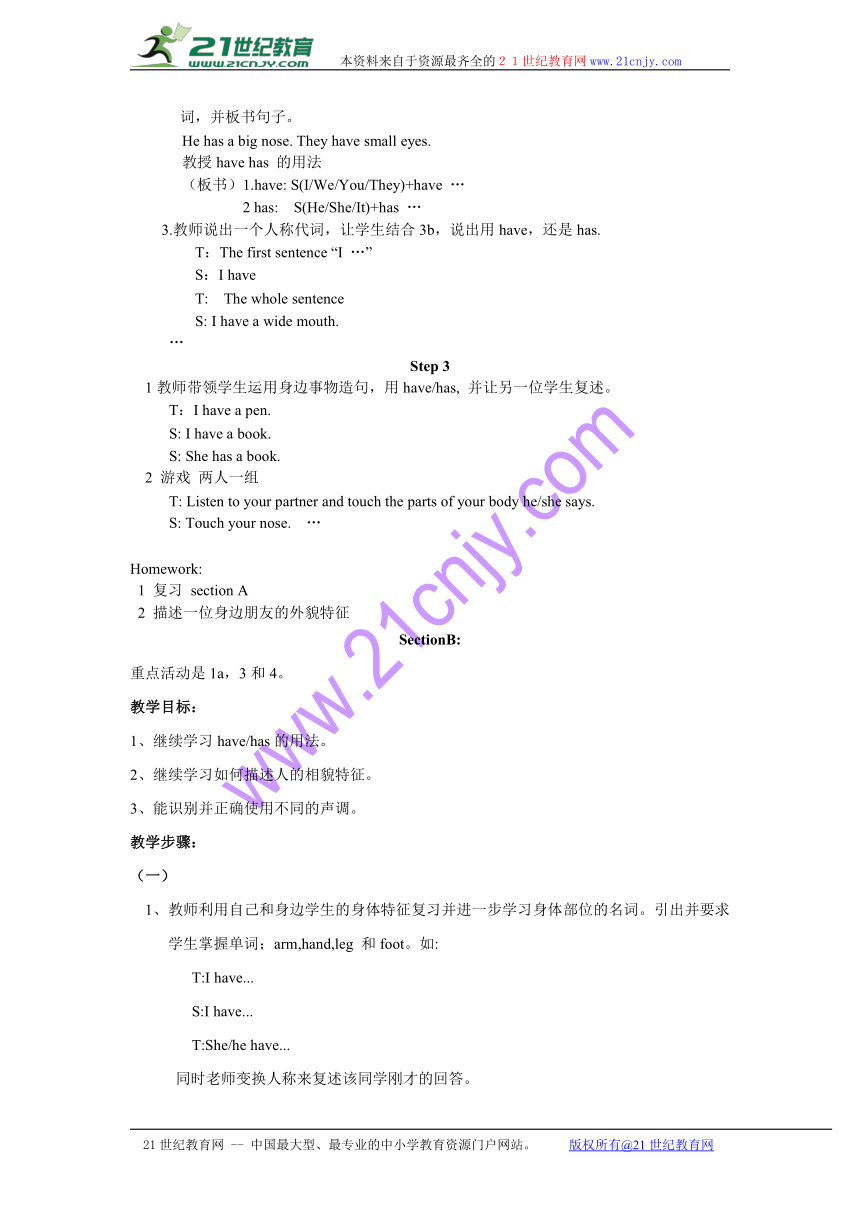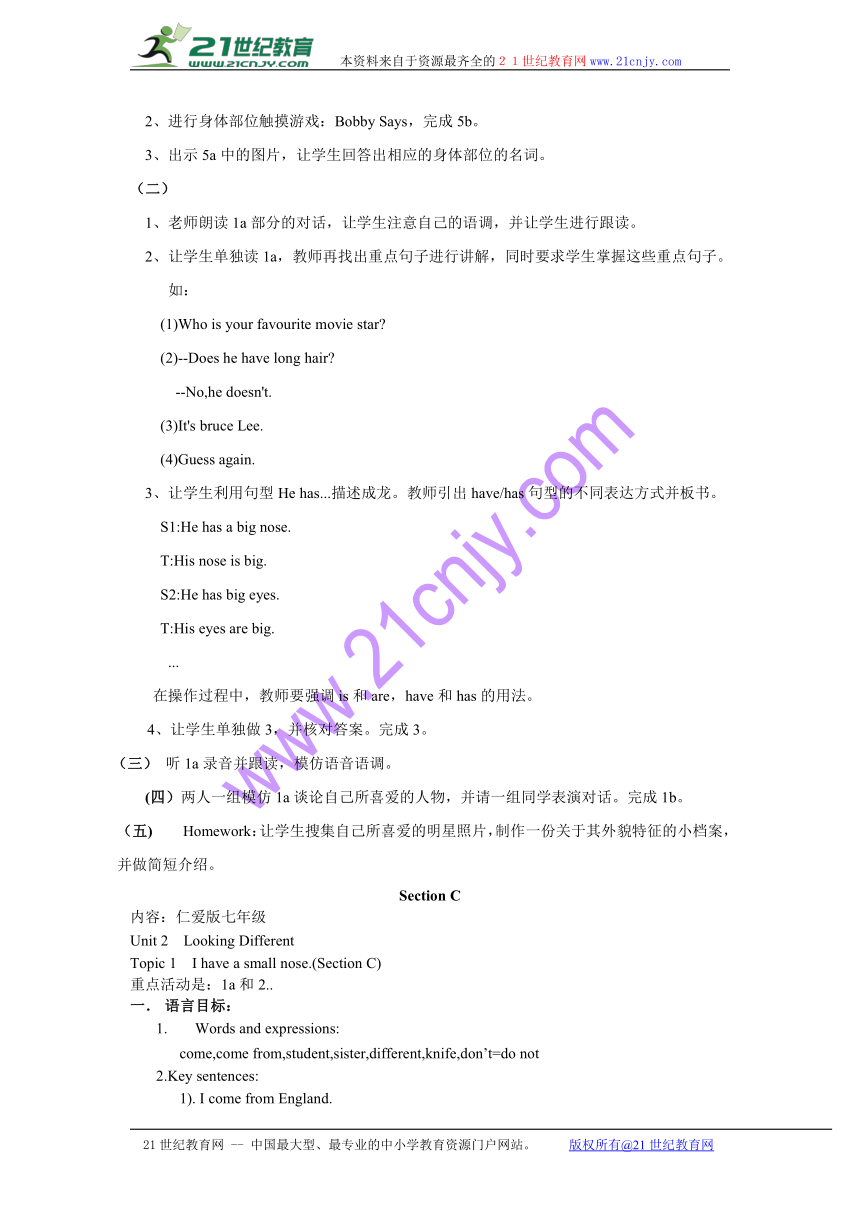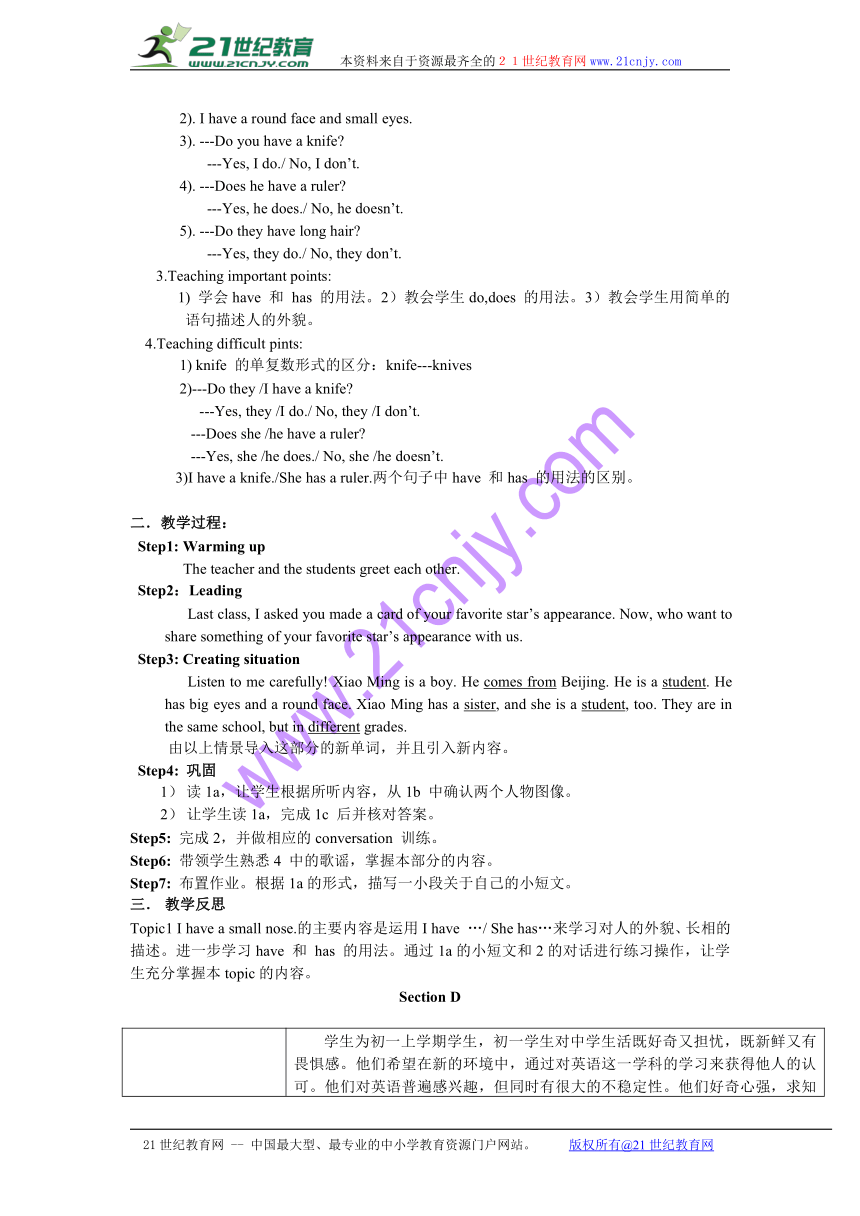Unit 2 Looking Different Topic 1 I have a small nose.教案
文档属性
| 名称 | Unit 2 Looking Different Topic 1 I have a small nose.教案 |  | |
| 格式 | zip | ||
| 文件大小 | 154.1KB | ||
| 资源类型 | 教案 | ||
| 版本资源 | 科普版 | ||
| 科目 | 英语 | ||
| 更新时间 | 2016-12-27 08:43:01 | ||
图片预览





文档简介
本资料来自于资源最齐全的21世纪教育网www.21cnjy.com
教案(仁爱版英语教材七年级上册)
Unit
2
Looking
Different
Topic
1
I
have
a
small
nose.
Section
A
1.
Teaching
aims
and
demands
教学目标
1.
Learn
some
useful
words
(1).
Learn
words
about
parts
of
the
body:
head,
hair,
face,
eye,
ear,
nose,
mouth,
neck
(2).
Learn
other
useful
words:
big,
s
mall,
long,
short,
wide,
round,
have,
has
2.
Learn
the
usage
of
“have”
and
“has”
(1)I
have
a
small
nose.
(2)They
have…
3.Learn
to
describe
people’s
appearances
二.教学步骤
Step
1.
Review
Name:
JaneAge:
12From:
CanadaSchool:
Guizhou
SchoolClass:
Two
Grade:
SevenPhone
number:
(0851)1234567
(1)
T:
What’s
her
name
S:
Her
name
is
Jane.
T:
How
old
is
she
S:
She
is
twelve.
T:
Where
is
she
from
S:
She
is
from
Canada.
T:
What
class
is
she
in
S:
She
is
in
Class
2,
Grade
7.
T:
What’s
her
telephone’s
number
S:
It’s
(0851)1234567.
(把全班学生分成两组就此对话表演)
Step
2
(根据以上内容导入新课)
T:
Well
done!
Now
we
( http: / / www.21cnjy.com )
have
learnt
something
about
Jane.
But
do
you
know
how
to
describe
her
appearances
So
first,
let’s
learn
some
words
about
parts
of
the
body.21教育网
1.
(板书单词,并带领学生拼读)
head
face
hair
eye
ear
nose
mouth
neck
/h
e
d/
/
f
ei
s/
/hε /
/ai/
/i /
/
n
au
z/
/
m
auθ/
/n
e
k/
2带领学生观察3a中图片突出的外貌特征,巩固表示人体部位的名词,学习部分形容词,并板书句子。
He
has
a
big
nose.
They
have
small
eyes.
教授have
has
的用法
(板书)1.have:
S(I/We/You/They)+have
…
2
has:
S(He/She/It)+has
…
3.教师说出一个人称代词,让学生结合3b,说出用have,还是has.
T:The
first
sentence
“I
…”
S:I
have
T:
The
whole
sentence
S:
I
have
a
wide
mouth.
…
Step
3
1教师带领学生运用身边事物造句,用have/has,
并让另一位学生复述。
T:I
have
a
pen.
S:
I
have
a
book.
S:
She
has
a
book.
2
游戏
两人一组
T:
Listen
to
your
par
( http: / / www.21cnjy.com )tner
and
touch
the
parts
of
your
body
he/she
says.
S:
Touch
your
nose.
…
Homework:
1
复习
section
A
2
描述一位身边朋友的外貌特征
SectionB:
重点活动是1a,3和4。
教学目标:
1、继续学习have/has的用法。
2、继续学习如何描述人的相貌特征。
3、能识别并正确使用不同的声调。
教学步骤:
(一)
1、教师利用自己和身边学生的身体特征复习并进一步学习身体部位的名词。引出并要求学生掌握单词;arm,hand,leg
和foot。如:21cnjy.com
T:I
have...
S:I
have...
T:She/he
have...
同时老师变换人称来复述该同学刚才的回答。
2、进行身体部位触摸游戏:Bobby
Says,完成5b。
3、出示5a中的图片,让学生回答出相应的身体部位的名词。
(二)
1、老师朗读1a部分的对话,让学生注意自己的语调,并让学生进行跟读。
2、让学生单独读1a,教师再找出重点句子进行讲解,同时要求学生掌握这些重点句子。如:
(1)Who
is
your
favourite
movie
star
(2)--Does
he
have
long
hair
--No,he
doesn't.
(3)It's
bruce
Lee.
(4)Guess
again.
3、让学生利用句型He
has...描述成龙。教师引出have/has句型的不同表达方式并板书。
S1:He
has
a
big
nose.
T:His
nose
is
big.
S2:He
has
big
eyes.
T:His
eyes
are
big.
...
在操作过程中,教师要强调is和are,have和has的用法。
4、让学生单独做3,并核对答案。完成3。
(三)
听1a录音并跟读,模仿语音语调。
(四)两人一组模仿1a谈论自己所喜爱的人物,并请一组同学表演对话。完成1b。
(五)
Homework:让学生搜集自己所喜爱的明星照片,制作一份关于其外貌特征的小档案,并做简短介绍。21·cn·jy·com
Section
C
内容:仁爱版七年级
Unit
2
Looking
Different
Topic
1
I
have
a
small
nose.(Section
C)
重点活动是:1a和2..
1.
语言目标:
1.
Words
and
expressions:
come,come
from,student,sister,different,knife,don’t=do
notwww.21-cn-jy.com
2.Key
sentences:
1).
I
come
from
England.
2).
I
have
a
round
face
and
small
eyes.
3).
---Do
you
have
a
knife
---Yes,
I
do./
No,
I
don’t.
4).
---Does
he
have
a
ruler
---Yes,
he
does./
No,
he
doesn’t.
5).
---Do
they
have
long
hair
---Yes,
they
do./
No,
they
don’t.
3.Teaching
important
points:
1)
学会have
和
has
的用法。2)教会学生do,does
的用法。3)教会学生用简单的语句描述人的外貌。2·1·c·n·j·y
4.Teaching
difficult
pints:
1)
knife
的单复数形式的区分:knife---knives
2)---Do
they
/I
have
a
knife
---Yes,
they
/I
do./
No,
they
/I
don’t.
---Does
she
/he
have
a
ruler
---Yes,
she
/he
does./
No,
she
/he
doesn’t.
3)I
have
a
knife./She
has
a
ruler.两个句子中have
和has
的用法的区别。
二.教学过程:
Step1:
Warming
up
The
teacher
and
the
students
greet
each
other.
Step2:Leading
Last
class,
I
( http: / / www.21cnjy.com )
asked
you
made
a
card
of
your
favorite
star’s
appearance.
Now,
who
want
to
share
something
of
your
favorite
star’s
appearance
with
us.【来源:21·世纪·教育·网】
Step3:
Creating
situation
Listen
to
me
carefu
( http: / / www.21cnjy.com )lly!
Xiao
Ming
is
a
boy.
He
comes
from
Beijing.
He
is
a
student.
He
has
big
eyes
and
a
round
face.
Xiao
Ming
has
a
sister,
and
she
is
a
student,
too.
They
are
in
the
same
school,
but
in
different
grades.21·世纪
教育网
由以上情景导入这部分的新单词,并且引入新内容。
Step4:
巩固
1)
读1a,让学生根据所听内容,从1b
中确认两个人物图像。
2)
让学生读1a,完成1c
后并核对答案。
Step5:
完成2,并做相应的conversation
训练。
Step6:
带领学生熟悉4
中的歌谣,掌握本部分的内容。
Step7:
布置作业。根据1a的形式,描写一小段关于自己的小短文。
3.
教学反思
Topic1
I
have
a
s
( http: / / www.21cnjy.com )mall
nose.的主要内容是运用I
have
…/
She
has…来学习对人的外貌、长相的描述。进一步学习have
和
has
的用法。通过1a的小短文和2的对话进行练习操作,让学生充分掌握本topic的内容。21世纪教育网版权所有
Section
D
上课班级情况概述Class
Description
学生为初一上学期学生,初一学生对中
( http: / / www.21cnjy.com )学生活既好奇又担忧,既新鲜又有畏惧感。他们希望在新的环境中,通过对英语这一学科的学习来获得他人的认可。他们对英语普遍感兴趣,但同时有很大的不稳定性。他们好奇心强,求知欲望盛。然而随着小学英语的开设,来自不同学校的学生英语水平参差不齐,因此两极分化现象从一开始就凸现出来。根据英语新课程标准:基础教育阶段英语课的总体目标是培养学生的综合运用语言能力。综合语言运用能力的形成建立在学生语言技能,语言知识,情感态度,学习策略和文化包容的态度。
教材依据和内容Teaching
Materials
and
Teaching
Content
仁爱版七年级上册Unit2
Looking
( http: / / www.21cnjy.com )
Different.
Topic1:
I
have
a
small
nose.
Section
D.
教学目标Teaching
objectives/aims
根据单元的教学内容、地位和作用,和英语新课程标准,以及学生现状分析确立如下教学目标:1.
语言知识目标
Target
language:重点词汇:Parts
of
the
body:
nose,
face,
hair,
mouth,
leg,
foot···
Adjectives:
big,
small,
long,
short,
round,
wide···
重点句型:1.
I
have
a
small
nose.2.
We/You/They
have
round
faces.3.
He/She/It
has
a
wide
mouth.4
Does
he
have
long
hair
Yes,
he
does./No,
he
doesn’t.
2.
语言技能目标Function:1.
Learn
the
consonants:/p/,
/b/,
/t/,
/d/,
/k/,
/g/2.
Review
the
( http: / / www.21cnjy.com )
simple
present
tense
with
“have/has”
and
adjectives
of
description:(1)He/She
has
small
eyes.(2)They
have
round
faces.(3)—Do
you
have
a
pencil
—Yes,
I
do./No,
I
don’t.(4)—Does
she
have
small
eyes
—Yes,
she
does./No,
she
doesn’t.3.
(1)Review
the
description
of
people’s
appearances:①I
have
a
big
nose.②My
face
is
round.③He
has
short
hair,
a
big
nose
and
a
wide
mouth.(2)Review
some
useful
expressions:①Who
is
your
favourite
movie
star
It’s
Bruce
Lee.②Yes,
you’re
right.③We
are
in
the
same
school,
but
in
different
grades.3.
情感态度目标Emotional1
教育学生生活中不是缺少美,而是缺少发现美的眼睛。培养学生热爱生活热爱美的情感,并培养他们的观察能力和概括能力。2
与同桌的对话编写,锻炼了学生的合作能力,挺高了学生们的协作精神。
教学辅助手段Teaching
Aids
Board—writing
Word
cards
Pictures
chalk
教学重点与难点Difficulties
and
Key
Points
1.教学重点:对人体各部位名词的掌握及描述相应特征的形容词。2.教学难点:如何正确使用have/has来描述人的相貌体征。
教学过程Teaching
Procedures
Allocation
of
Time
Step1:Pre-teaching
Revision/
Warming
up
Step
1
Review
第一步
复习(时间:12分钟)1.
(利用身体部位复习本单元的单词和主要句型。)(1)(利用身体部位进行集体认读单词活动,事先把单词进行归类,如身体部位类、形容词类等。)(2)(老师展示中文意思,以必答的形式让学生拼读单词)T:
I’ll
show
( http: / / www.21cnjy.com )
you
the
Chinese
meanings
of
the
words.
You
should
spell
them
one
by
one
quickly.
OK Ss:
Yes.T:
OK.
Let’s
begin.S1:
N-O-S-E,
nose.T:
Good.
Next.S2:
L-O-N-G,
long.T:
Good.
Next
one.S3:
H-A-V-E,
have.T:
Next.S4:
Er
...T:
Next
one.S5:
R-I-G-H-T,
right.T:
…(如果这个学生没法回答,由下一位学生来回答)2.
(师生互动问答,对Do
you
have…
句型进行复习。)T:
Do
you
have
big
ears S11:
Yes,
I
do.T:
Do
you
have
a
big
nose S12:
No,
I
don’t.T:
Do
you
…
…3.
(学生快速一个接着一个的进行Do
you
have
… 句型的问答复习,老师可以先开个头。)T:
Do
you
have
big
ears S13:
No,
I
don’t.
Do
you
have
small
ears S14:
Yes,
I
do.
Do
you
have
long
hair S15:
Yes,
I
do.
Do
you
…
S16:
…4.
(根据上一节课布置的作业,请一位学生描述自己母亲的外貌,鼓励学生主动参与描述。)T:
Very
good.
Now
let
us
describe
your
mothers.
···
please.···:
My
mother
has
short
hair,
big
ears
and
a
small
mouth.T:
Great.
Another
one.S17:
…Step
2
Presentation
第二步
呈现(时间:8分钟)1.
(让学生看书上31页,通过学生拼读方式来完成,注意突出/p/,
/b/,
/t/,
/d/,
/k/,
/g/的读音。)T:
OK.
Boys
and
gir
( http: / / www.21cnjy.com )ls,
attention
please.
Look
at
the
Page
31.
Read
and
spell
them.Ss:
Pen,
P-E-N,
pen.Ss:
Plane,
P-L-A-N-E,
plane.Ss:
Apple,
A-P-P-L-E,
apple.(板书单词与/p/,用彩色突出单词中的字母p,然后齐声朗读。)/p/
pen
plane
apple
(用已学音标,启发学生读这个单词)
T:
Now
look
at
the
blackboard
and
read
them
together.
(以同样的方式学习/p/,
/b/,
/t/,
/d/,
/k/,
/g/)
/b/
bus
book
bag/t/
cat
photo
bot
tle/d/
doctor
hand
dumplings/k/
desk
chicken
cup/g/
girl
glass
tigerStep
3
Consolidation
第三步
巩固(时间:7分钟)1.
(让学生跟读并为每个音标再找一个例词来补充,从而加深印象。)T:
Who
can
find
another
word
with
/p/
sound S1:
Please.T:
Good.
Thank
you.T:
Who
can
find
another
word
with
/b/
sound S2:
Box.T:
Very
good.
Thank
you.
```Step
4
Practice
第四步
练习(时间:8分钟)1.
(1)(利用书中Kangkang的图片进行师生互动问答,复习有关描述外貌的句型。)T:
Who
is
this
boy Ss:
He
is
Kangkang.T:
Does
he
have
a
big
head Ss:
Yes,
he
does.T:
Does
he
have
a
big
nose Ss:
No,
he
doesn’t.T:
Does
… Ss:
…(再呈现一张Amy的图片,
进行类似上面的练习。)T:
Who
is
this
girl Ss:
She
is
Amy.T:
…Ss:
……(2)(让学生根据图片,两人一组进行类似的口语练习。)S1:
Who’s
this
boy S2:
He
is
Kangkang.S1:
…S2:
……(3)(根据班上学生的外貌特征,让学生表演对话。)S3:
Hello,
S4!
Who
is
this
girl S4:
Hello!
She
is
Li
Mei.S3:
Does
she
have
long
hair S4:
Yes,
she
does.…(4)(让学生完整地描述老师的外貌。)S5:
This
is
my
teac
( http: / / www.21cnjy.com )her,
Mr.
Chen.
He
has
short
hair.
He
has
a
small
nose.
…
I
like
him.T:
Well
done!
Thank
you.2.
(1)T:
Look
at
the
pi
( http: / / www.21cnjy.com )cture
in
Part
2.
We
can
see
some
boys.
They
are
playing
soccer.
Now
listen
to
the
tape
and
number
the
players
in
the
order
you
hear.(2)(核对答案,再听1遍,让学生写出所听到的句子,可利用暂停键操作。)T:
Listen
to
the
tape
and
try
to
write
down
the
whole
sentences.①Li
Ming
has
big
hands.②Tom’s
arms
are
very
long.③Peter
has
big
feet.④Kangkang
has
a
big
head.3.
(放3a和3b录音,学生跟读。然后学生齐读。师生一起总结,完成3a和3b。)T:
Listen
and
repeat.
Then
read
together.Step
5
Project
第五步
综合探究活动(时间:10分钟)1.
(老师让学生两人一组,通过相互问答的方式获取有用信息,完成5中1的表格。活动前老师可为学生提供一些有用的句型。)T:
Now
work
in
pairs
( http: / / www.21cnjy.com ).
Ask
your
partner
some
questions
about
his/her
teacher/friend.
Then
fill
out
the
table
according
to
his/her
answers.S1:
Who
is
your
favorite
teacher S2:
Miss
Li.S1:
Does
she
have
a
round
face S2:
Yes,
she
does.S1:
Is
her
mouth
wide S2:
No,
it
isn’t.
Her
mouth
is
small.(S1依次询问S2的老师或朋友的外貌特征,并依据S2的回答完成表格,然后两人交换角色继续问答。)2.(带领学生完成4。)T:
Sing
this
song.
( http: / / www.21cnjy.com )
Touch
the
parts
of
your
body
while
you
are
singing.3.
Homework
补充材料Supplementary
Materials
评价设计
评价目的评价是英语课
( http: / / www.21cnjy.com )程的有机组成部分,是实现英语新刻标的重要保障。英语教学的评价包括测试性和非测试性教学评价,形成性和终结性评价不同的区分方式,从单纯的测试到评价是质的飞跃为了全面了解学生的学习情况,激发学生的学习热情,促进学生的可持续发展,要学生认识自我树立自信,对学生进行形成性和终结性相结合的教学评价。通过评价,一方面对教师而言可以获取英语教学的反馈知识,即检查自己的教学方法和教学手段对学生是否使用适时的总结教学经验改进教学方法不断完善自我;另一方面,对学生而言使学生能够了解自己的薄弱环节不断调整学习方法。
课后作业Assignment
Homework:(1)复习Unit
2,
Topic
1的主要句型。(2)写一篇关于你的兄弟姐妹或朋友的外貌特征的短文。
板
书设
计
Unit2
Looking
Different.
Hand-writingDesign
Topic1:I
have
a
small
nose.
Section
D1.
/p/
pen
plane
apple
2.①Li
Ming
has
big
hands./b/
bus
book
bag
②Tom’s
arms
are
very
long./t/
cat
photo
bottle
③Peter
has
big
feet./d/
doctor
hand
dumplings
④Kangkang
has
a
big
head./k/
desk
chicken
cup/g/
girl
glass
tiger
设计意图:1)英语教学主要任务之一是培养
( http: / / www.21cnjy.com )学生良好的学习习惯和学习兴趣,培养他们交际和运用英语的能力。其次,应重视学生学习英语兴趣的培养,激发学生的学习兴趣。再者,在新形势下,转变教学思想是搞好新教材教法的前提,更新观念是用好教材的保证。英语教师在实际教学中应自觉转变过去以应试为目的的教育思想,充分发挥教材的优势特点。2)运用交际手段,培养学生的能力。绝大
( http: / / www.21cnjy.com )部分学生主要是在课堂上学习英语,而在现实生活中缺少语言交际的环境和场所。在教学中我努力创设和提供情景操练的机会,尽可能地将真实生活搬进课堂,注意在教学中为学生创设语言交际的环境。同时,还注意到交际是双向性的,是说者和听者双向交流思想的过程。在这一过程中,双方地位是不断发生变化,互相转换的。【教学总结与反思】教学结果的预测:通过教学评价激励学生学习,帮助学生有效控制
( http: / / www.21cnjy.com )自己的学习过程,使学生获得成就感,增强自信心和合作精神。图片的使用和联系身边实物教学使学生对所学知识充满兴趣。一系列任务教学帮助学生主动复习重难点,提高了综合运用语言能力,体现了评价改革的要求,注重了学生的自评和互评,并把英语学习、活动和评价紧密的结合起来,反映了学生学习和评价的关系,促进了学生自主性的发展和自信心的建立。并体现了学生的主体地位和教师的主导作用,以达到预期的教学目标。总结和反思:本话题的整体设计使学生掌握如
( http: / / www.21cnjy.com )何正确描述人的外貌特征,联系身边生活实际使学生有话可说有感而发,真正的达到了学以致用,促使他们在整个教学活动中主动参与。但我个人认为仍有几处值得商榷,如:1在讲解呈现新知的过程中,色彩鲜艳的人物图片是否会分散学生的注意力?是否梯度过大忽略了学困生?2本话题教学中,目标语言较少,单词量大,是否会削弱学生学习英语的兴趣?3评价表格过多,课堂时间有限,是否可行?能否达到评价效果?
21世纪教育网
--
中国最大型、最专业的中小学教育资源门户网站。
版权所有@21世纪教育网
教案(仁爱版英语教材七年级上册)
Unit
2
Looking
Different
Topic
1
I
have
a
small
nose.
Section
A
1.
Teaching
aims
and
demands
教学目标
1.
Learn
some
useful
words
(1).
Learn
words
about
parts
of
the
body:
head,
hair,
face,
eye,
ear,
nose,
mouth,
neck
(2).
Learn
other
useful
words:
big,
s
mall,
long,
short,
wide,
round,
have,
has
2.
Learn
the
usage
of
“have”
and
“has”
(1)I
have
a
small
nose.
(2)They
have…
3.Learn
to
describe
people’s
appearances
二.教学步骤
Step
1.
Review
Name:
JaneAge:
12From:
CanadaSchool:
Guizhou
SchoolClass:
Two
Grade:
SevenPhone
number:
(0851)1234567
(1)
T:
What’s
her
name
S:
Her
name
is
Jane.
T:
How
old
is
she
S:
She
is
twelve.
T:
Where
is
she
from
S:
She
is
from
Canada.
T:
What
class
is
she
in
S:
She
is
in
Class
2,
Grade
7.
T:
What’s
her
telephone’s
number
S:
It’s
(0851)1234567.
(把全班学生分成两组就此对话表演)
Step
2
(根据以上内容导入新课)
T:
Well
done!
Now
we
( http: / / www.21cnjy.com )
have
learnt
something
about
Jane.
But
do
you
know
how
to
describe
her
appearances
So
first,
let’s
learn
some
words
about
parts
of
the
body.21教育网
1.
(板书单词,并带领学生拼读)
head
face
hair
eye
ear
nose
mouth
neck
/h
e
d/
/
f
ei
s/
/hε /
/ai/
/i /
/
n
au
z/
/
m
auθ/
/n
e
k/
2带领学生观察3a中图片突出的外貌特征,巩固表示人体部位的名词,学习部分形容词,并板书句子。
He
has
a
big
nose.
They
have
small
eyes.
教授have
has
的用法
(板书)1.have:
S(I/We/You/They)+have
…
2
has:
S(He/She/It)+has
…
3.教师说出一个人称代词,让学生结合3b,说出用have,还是has.
T:The
first
sentence
“I
…”
S:I
have
T:
The
whole
sentence
S:
I
have
a
wide
mouth.
…
Step
3
1教师带领学生运用身边事物造句,用have/has,
并让另一位学生复述。
T:I
have
a
pen.
S:
I
have
a
book.
S:
She
has
a
book.
2
游戏
两人一组
T:
Listen
to
your
par
( http: / / www.21cnjy.com )tner
and
touch
the
parts
of
your
body
he/she
says.
S:
Touch
your
nose.
…
Homework:
1
复习
section
A
2
描述一位身边朋友的外貌特征
SectionB:
重点活动是1a,3和4。
教学目标:
1、继续学习have/has的用法。
2、继续学习如何描述人的相貌特征。
3、能识别并正确使用不同的声调。
教学步骤:
(一)
1、教师利用自己和身边学生的身体特征复习并进一步学习身体部位的名词。引出并要求学生掌握单词;arm,hand,leg
和foot。如:21cnjy.com
T:I
have...
S:I
have...
T:She/he
have...
同时老师变换人称来复述该同学刚才的回答。
2、进行身体部位触摸游戏:Bobby
Says,完成5b。
3、出示5a中的图片,让学生回答出相应的身体部位的名词。
(二)
1、老师朗读1a部分的对话,让学生注意自己的语调,并让学生进行跟读。
2、让学生单独读1a,教师再找出重点句子进行讲解,同时要求学生掌握这些重点句子。如:
(1)Who
is
your
favourite
movie
star
(2)--Does
he
have
long
hair
--No,he
doesn't.
(3)It's
bruce
Lee.
(4)Guess
again.
3、让学生利用句型He
has...描述成龙。教师引出have/has句型的不同表达方式并板书。
S1:He
has
a
big
nose.
T:His
nose
is
big.
S2:He
has
big
eyes.
T:His
eyes
are
big.
...
在操作过程中,教师要强调is和are,have和has的用法。
4、让学生单独做3,并核对答案。完成3。
(三)
听1a录音并跟读,模仿语音语调。
(四)两人一组模仿1a谈论自己所喜爱的人物,并请一组同学表演对话。完成1b。
(五)
Homework:让学生搜集自己所喜爱的明星照片,制作一份关于其外貌特征的小档案,并做简短介绍。21·cn·jy·com
Section
C
内容:仁爱版七年级
Unit
2
Looking
Different
Topic
1
I
have
a
small
nose.(Section
C)
重点活动是:1a和2..
1.
语言目标:
1.
Words
and
expressions:
come,come
from,student,sister,different,knife,don’t=do
notwww.21-cn-jy.com
2.Key
sentences:
1).
I
come
from
England.
2).
I
have
a
round
face
and
small
eyes.
3).
---Do
you
have
a
knife
---Yes,
I
do./
No,
I
don’t.
4).
---Does
he
have
a
ruler
---Yes,
he
does./
No,
he
doesn’t.
5).
---Do
they
have
long
hair
---Yes,
they
do./
No,
they
don’t.
3.Teaching
important
points:
1)
学会have
和
has
的用法。2)教会学生do,does
的用法。3)教会学生用简单的语句描述人的外貌。2·1·c·n·j·y
4.Teaching
difficult
pints:
1)
knife
的单复数形式的区分:knife---knives
2)---Do
they
/I
have
a
knife
---Yes,
they
/I
do./
No,
they
/I
don’t.
---Does
she
/he
have
a
ruler
---Yes,
she
/he
does./
No,
she
/he
doesn’t.
3)I
have
a
knife./She
has
a
ruler.两个句子中have
和has
的用法的区别。
二.教学过程:
Step1:
Warming
up
The
teacher
and
the
students
greet
each
other.
Step2:Leading
Last
class,
I
( http: / / www.21cnjy.com )
asked
you
made
a
card
of
your
favorite
star’s
appearance.
Now,
who
want
to
share
something
of
your
favorite
star’s
appearance
with
us.【来源:21·世纪·教育·网】
Step3:
Creating
situation
Listen
to
me
carefu
( http: / / www.21cnjy.com )lly!
Xiao
Ming
is
a
boy.
He
comes
from
Beijing.
He
is
a
student.
He
has
big
eyes
and
a
round
face.
Xiao
Ming
has
a
sister,
and
she
is
a
student,
too.
They
are
in
the
same
school,
but
in
different
grades.21·世纪
教育网
由以上情景导入这部分的新单词,并且引入新内容。
Step4:
巩固
1)
读1a,让学生根据所听内容,从1b
中确认两个人物图像。
2)
让学生读1a,完成1c
后并核对答案。
Step5:
完成2,并做相应的conversation
训练。
Step6:
带领学生熟悉4
中的歌谣,掌握本部分的内容。
Step7:
布置作业。根据1a的形式,描写一小段关于自己的小短文。
3.
教学反思
Topic1
I
have
a
s
( http: / / www.21cnjy.com )mall
nose.的主要内容是运用I
have
…/
She
has…来学习对人的外貌、长相的描述。进一步学习have
和
has
的用法。通过1a的小短文和2的对话进行练习操作,让学生充分掌握本topic的内容。21世纪教育网版权所有
Section
D
上课班级情况概述Class
Description
学生为初一上学期学生,初一学生对中
( http: / / www.21cnjy.com )学生活既好奇又担忧,既新鲜又有畏惧感。他们希望在新的环境中,通过对英语这一学科的学习来获得他人的认可。他们对英语普遍感兴趣,但同时有很大的不稳定性。他们好奇心强,求知欲望盛。然而随着小学英语的开设,来自不同学校的学生英语水平参差不齐,因此两极分化现象从一开始就凸现出来。根据英语新课程标准:基础教育阶段英语课的总体目标是培养学生的综合运用语言能力。综合语言运用能力的形成建立在学生语言技能,语言知识,情感态度,学习策略和文化包容的态度。
教材依据和内容Teaching
Materials
and
Teaching
Content
仁爱版七年级上册Unit2
Looking
( http: / / www.21cnjy.com )
Different.
Topic1:
I
have
a
small
nose.
Section
D.
教学目标Teaching
objectives/aims
根据单元的教学内容、地位和作用,和英语新课程标准,以及学生现状分析确立如下教学目标:1.
语言知识目标
Target
language:重点词汇:Parts
of
the
body:
nose,
face,
hair,
mouth,
leg,
foot···
Adjectives:
big,
small,
long,
short,
round,
wide···
重点句型:1.
I
have
a
small
nose.2.
We/You/They
have
round
faces.3.
He/She/It
has
a
wide
mouth.4
Does
he
have
long
hair
Yes,
he
does./No,
he
doesn’t.
2.
语言技能目标Function:1.
Learn
the
consonants:/p/,
/b/,
/t/,
/d/,
/k/,
/g/2.
Review
the
( http: / / www.21cnjy.com )
simple
present
tense
with
“have/has”
and
adjectives
of
description:(1)He/She
has
small
eyes.(2)They
have
round
faces.(3)—Do
you
have
a
pencil
—Yes,
I
do./No,
I
don’t.(4)—Does
she
have
small
eyes
—Yes,
she
does./No,
she
doesn’t.3.
(1)Review
the
description
of
people’s
appearances:①I
have
a
big
nose.②My
face
is
round.③He
has
short
hair,
a
big
nose
and
a
wide
mouth.(2)Review
some
useful
expressions:①Who
is
your
favourite
movie
star
It’s
Bruce
Lee.②Yes,
you’re
right.③We
are
in
the
same
school,
but
in
different
grades.3.
情感态度目标Emotional1
教育学生生活中不是缺少美,而是缺少发现美的眼睛。培养学生热爱生活热爱美的情感,并培养他们的观察能力和概括能力。2
与同桌的对话编写,锻炼了学生的合作能力,挺高了学生们的协作精神。
教学辅助手段Teaching
Aids
Board—writing
Word
cards
Pictures
chalk
教学重点与难点Difficulties
and
Key
Points
1.教学重点:对人体各部位名词的掌握及描述相应特征的形容词。2.教学难点:如何正确使用have/has来描述人的相貌体征。
教学过程Teaching
Procedures
Allocation
of
Time
Step1:Pre-teaching
Revision/
Warming
up
Step
1
Review
第一步
复习(时间:12分钟)1.
(利用身体部位复习本单元的单词和主要句型。)(1)(利用身体部位进行集体认读单词活动,事先把单词进行归类,如身体部位类、形容词类等。)(2)(老师展示中文意思,以必答的形式让学生拼读单词)T:
I’ll
show
( http: / / www.21cnjy.com )
you
the
Chinese
meanings
of
the
words.
You
should
spell
them
one
by
one
quickly.
OK Ss:
Yes.T:
OK.
Let’s
begin.S1:
N-O-S-E,
nose.T:
Good.
Next.S2:
L-O-N-G,
long.T:
Good.
Next
one.S3:
H-A-V-E,
have.T:
Next.S4:
Er
...T:
Next
one.S5:
R-I-G-H-T,
right.T:
…(如果这个学生没法回答,由下一位学生来回答)2.
(师生互动问答,对Do
you
have…
句型进行复习。)T:
Do
you
have
big
ears S11:
Yes,
I
do.T:
Do
you
have
a
big
nose S12:
No,
I
don’t.T:
Do
you
…
…3.
(学生快速一个接着一个的进行Do
you
have
… 句型的问答复习,老师可以先开个头。)T:
Do
you
have
big
ears S13:
No,
I
don’t.
Do
you
have
small
ears S14:
Yes,
I
do.
Do
you
have
long
hair S15:
Yes,
I
do.
Do
you
…
S16:
…4.
(根据上一节课布置的作业,请一位学生描述自己母亲的外貌,鼓励学生主动参与描述。)T:
Very
good.
Now
let
us
describe
your
mothers.
···
please.···:
My
mother
has
short
hair,
big
ears
and
a
small
mouth.T:
Great.
Another
one.S17:
…Step
2
Presentation
第二步
呈现(时间:8分钟)1.
(让学生看书上31页,通过学生拼读方式来完成,注意突出/p/,
/b/,
/t/,
/d/,
/k/,
/g/的读音。)T:
OK.
Boys
and
gir
( http: / / www.21cnjy.com )ls,
attention
please.
Look
at
the
Page
31.
Read
and
spell
them.Ss:
Pen,
P-E-N,
pen.Ss:
Plane,
P-L-A-N-E,
plane.Ss:
Apple,
A-P-P-L-E,
apple.(板书单词与/p/,用彩色突出单词中的字母p,然后齐声朗读。)/p/
pen
plane
apple
(用已学音标,启发学生读这个单词)
T:
Now
look
at
the
blackboard
and
read
them
together.
(以同样的方式学习/p/,
/b/,
/t/,
/d/,
/k/,
/g/)
/b/
bus
book
bag/t/
cat
photo
bot
tle/d/
doctor
hand
dumplings/k/
desk
chicken
cup/g/
girl
glass
tigerStep
3
Consolidation
第三步
巩固(时间:7分钟)1.
(让学生跟读并为每个音标再找一个例词来补充,从而加深印象。)T:
Who
can
find
another
word
with
/p/
sound S1:
Please.T:
Good.
Thank
you.T:
Who
can
find
another
word
with
/b/
sound S2:
Box.T:
Very
good.
Thank
you.
```Step
4
Practice
第四步
练习(时间:8分钟)1.
(1)(利用书中Kangkang的图片进行师生互动问答,复习有关描述外貌的句型。)T:
Who
is
this
boy Ss:
He
is
Kangkang.T:
Does
he
have
a
big
head Ss:
Yes,
he
does.T:
Does
he
have
a
big
nose Ss:
No,
he
doesn’t.T:
Does
… Ss:
…(再呈现一张Amy的图片,
进行类似上面的练习。)T:
Who
is
this
girl Ss:
She
is
Amy.T:
…Ss:
……(2)(让学生根据图片,两人一组进行类似的口语练习。)S1:
Who’s
this
boy S2:
He
is
Kangkang.S1:
…S2:
……(3)(根据班上学生的外貌特征,让学生表演对话。)S3:
Hello,
S4!
Who
is
this
girl S4:
Hello!
She
is
Li
Mei.S3:
Does
she
have
long
hair S4:
Yes,
she
does.…(4)(让学生完整地描述老师的外貌。)S5:
This
is
my
teac
( http: / / www.21cnjy.com )her,
Mr.
Chen.
He
has
short
hair.
He
has
a
small
nose.
…
I
like
him.T:
Well
done!
Thank
you.2.
(1)T:
Look
at
the
pi
( http: / / www.21cnjy.com )cture
in
Part
2.
We
can
see
some
boys.
They
are
playing
soccer.
Now
listen
to
the
tape
and
number
the
players
in
the
order
you
hear.(2)(核对答案,再听1遍,让学生写出所听到的句子,可利用暂停键操作。)T:
Listen
to
the
tape
and
try
to
write
down
the
whole
sentences.①Li
Ming
has
big
hands.②Tom’s
arms
are
very
long.③Peter
has
big
feet.④Kangkang
has
a
big
head.3.
(放3a和3b录音,学生跟读。然后学生齐读。师生一起总结,完成3a和3b。)T:
Listen
and
repeat.
Then
read
together.Step
5
Project
第五步
综合探究活动(时间:10分钟)1.
(老师让学生两人一组,通过相互问答的方式获取有用信息,完成5中1的表格。活动前老师可为学生提供一些有用的句型。)T:
Now
work
in
pairs
( http: / / www.21cnjy.com ).
Ask
your
partner
some
questions
about
his/her
teacher/friend.
Then
fill
out
the
table
according
to
his/her
answers.S1:
Who
is
your
favorite
teacher S2:
Miss
Li.S1:
Does
she
have
a
round
face S2:
Yes,
she
does.S1:
Is
her
mouth
wide S2:
No,
it
isn’t.
Her
mouth
is
small.(S1依次询问S2的老师或朋友的外貌特征,并依据S2的回答完成表格,然后两人交换角色继续问答。)2.(带领学生完成4。)T:
Sing
this
song.
( http: / / www.21cnjy.com )
Touch
the
parts
of
your
body
while
you
are
singing.3.
Homework
补充材料Supplementary
Materials
评价设计
评价目的评价是英语课
( http: / / www.21cnjy.com )程的有机组成部分,是实现英语新刻标的重要保障。英语教学的评价包括测试性和非测试性教学评价,形成性和终结性评价不同的区分方式,从单纯的测试到评价是质的飞跃为了全面了解学生的学习情况,激发学生的学习热情,促进学生的可持续发展,要学生认识自我树立自信,对学生进行形成性和终结性相结合的教学评价。通过评价,一方面对教师而言可以获取英语教学的反馈知识,即检查自己的教学方法和教学手段对学生是否使用适时的总结教学经验改进教学方法不断完善自我;另一方面,对学生而言使学生能够了解自己的薄弱环节不断调整学习方法。
课后作业Assignment
Homework:(1)复习Unit
2,
Topic
1的主要句型。(2)写一篇关于你的兄弟姐妹或朋友的外貌特征的短文。
板
书设
计
Unit2
Looking
Different.
Hand-writingDesign
Topic1:I
have
a
small
nose.
Section
D1.
/p/
pen
plane
apple
2.①Li
Ming
has
big
hands./b/
bus
book
bag
②Tom’s
arms
are
very
long./t/
cat
photo
bottle
③Peter
has
big
feet./d/
doctor
hand
dumplings
④Kangkang
has
a
big
head./k/
desk
chicken
cup/g/
girl
glass
tiger
设计意图:1)英语教学主要任务之一是培养
( http: / / www.21cnjy.com )学生良好的学习习惯和学习兴趣,培养他们交际和运用英语的能力。其次,应重视学生学习英语兴趣的培养,激发学生的学习兴趣。再者,在新形势下,转变教学思想是搞好新教材教法的前提,更新观念是用好教材的保证。英语教师在实际教学中应自觉转变过去以应试为目的的教育思想,充分发挥教材的优势特点。2)运用交际手段,培养学生的能力。绝大
( http: / / www.21cnjy.com )部分学生主要是在课堂上学习英语,而在现实生活中缺少语言交际的环境和场所。在教学中我努力创设和提供情景操练的机会,尽可能地将真实生活搬进课堂,注意在教学中为学生创设语言交际的环境。同时,还注意到交际是双向性的,是说者和听者双向交流思想的过程。在这一过程中,双方地位是不断发生变化,互相转换的。【教学总结与反思】教学结果的预测:通过教学评价激励学生学习,帮助学生有效控制
( http: / / www.21cnjy.com )自己的学习过程,使学生获得成就感,增强自信心和合作精神。图片的使用和联系身边实物教学使学生对所学知识充满兴趣。一系列任务教学帮助学生主动复习重难点,提高了综合运用语言能力,体现了评价改革的要求,注重了学生的自评和互评,并把英语学习、活动和评价紧密的结合起来,反映了学生学习和评价的关系,促进了学生自主性的发展和自信心的建立。并体现了学生的主体地位和教师的主导作用,以达到预期的教学目标。总结和反思:本话题的整体设计使学生掌握如
( http: / / www.21cnjy.com )何正确描述人的外貌特征,联系身边生活实际使学生有话可说有感而发,真正的达到了学以致用,促使他们在整个教学活动中主动参与。但我个人认为仍有几处值得商榷,如:1在讲解呈现新知的过程中,色彩鲜艳的人物图片是否会分散学生的注意力?是否梯度过大忽略了学困生?2本话题教学中,目标语言较少,单词量大,是否会削弱学生学习英语的兴趣?3评价表格过多,课堂时间有限,是否可行?能否达到评价效果?
21世纪教育网
--
中国最大型、最专业的中小学教育资源门户网站。
版权所有@21世纪教育网
同课章节目录
- Unit 1 Making new friends
- Topic 1 Welcome to China!
- Topic 2 Where are you from?
- Topic 3 How old are you?
- Unit 2 Looking different
- Topic 1 I have a small nose
- Topic 2 What does she look like?
- Topic 3 Whose jacket is this?
- Unit 3 Getting togethe
- Topic 1 Does he speak Chinese?
- Topic 2 What do your parents do?
- Topic 3 What would you like to drink?
- Unit 4 Having fun
- Topic 1 What can I do for you?
- Topic 2 Would you like to cook with us?
- Topic 3 What time is it now?
